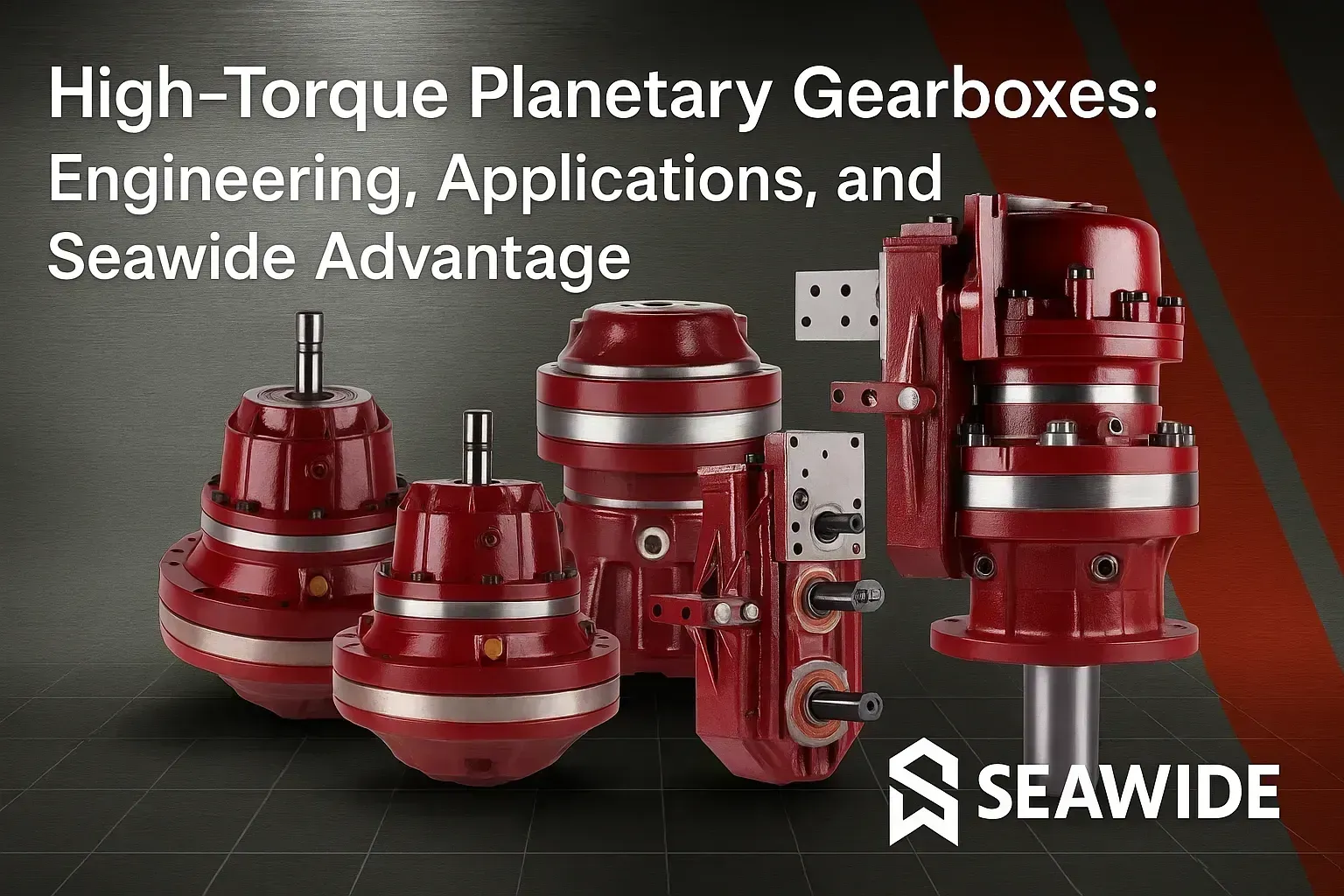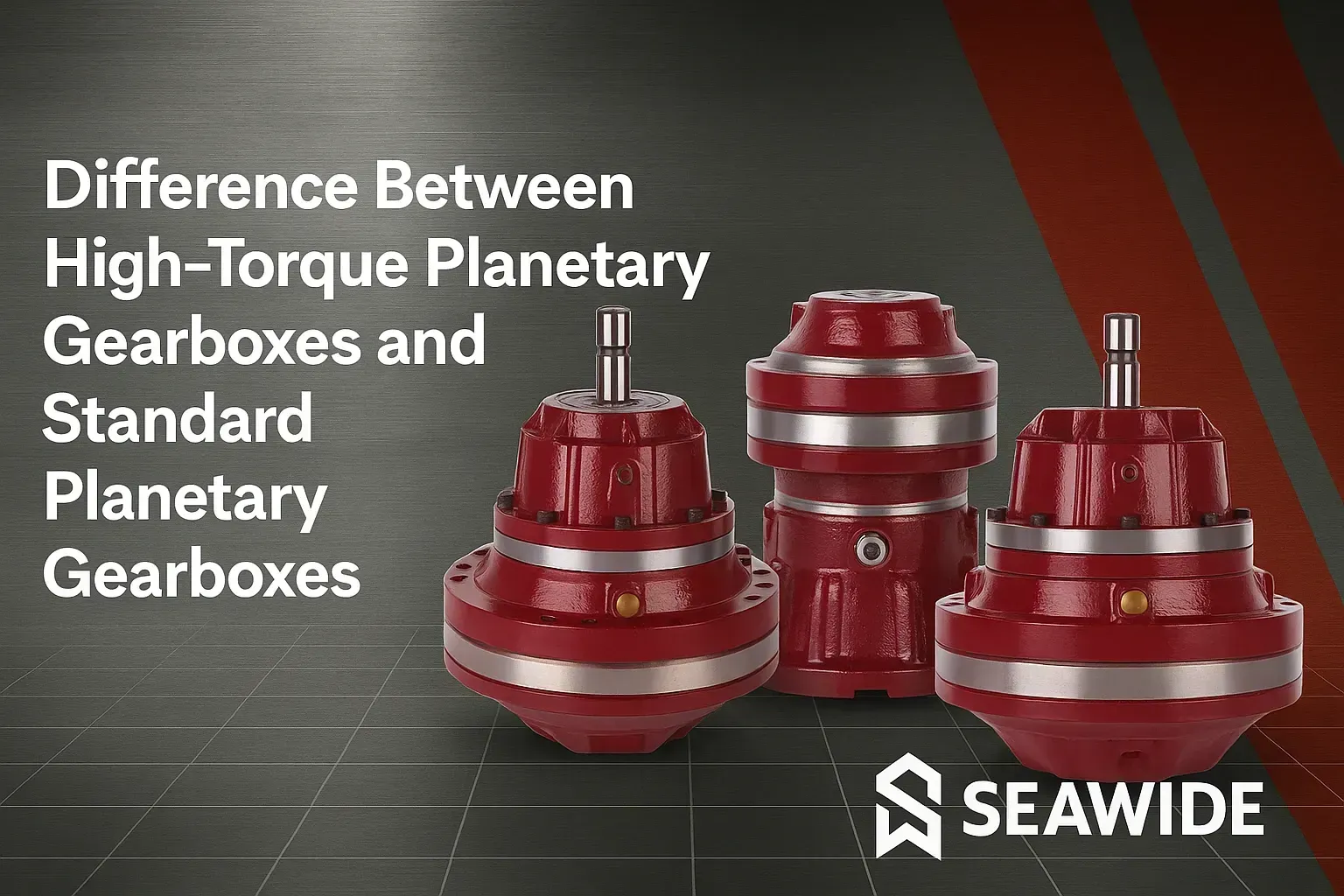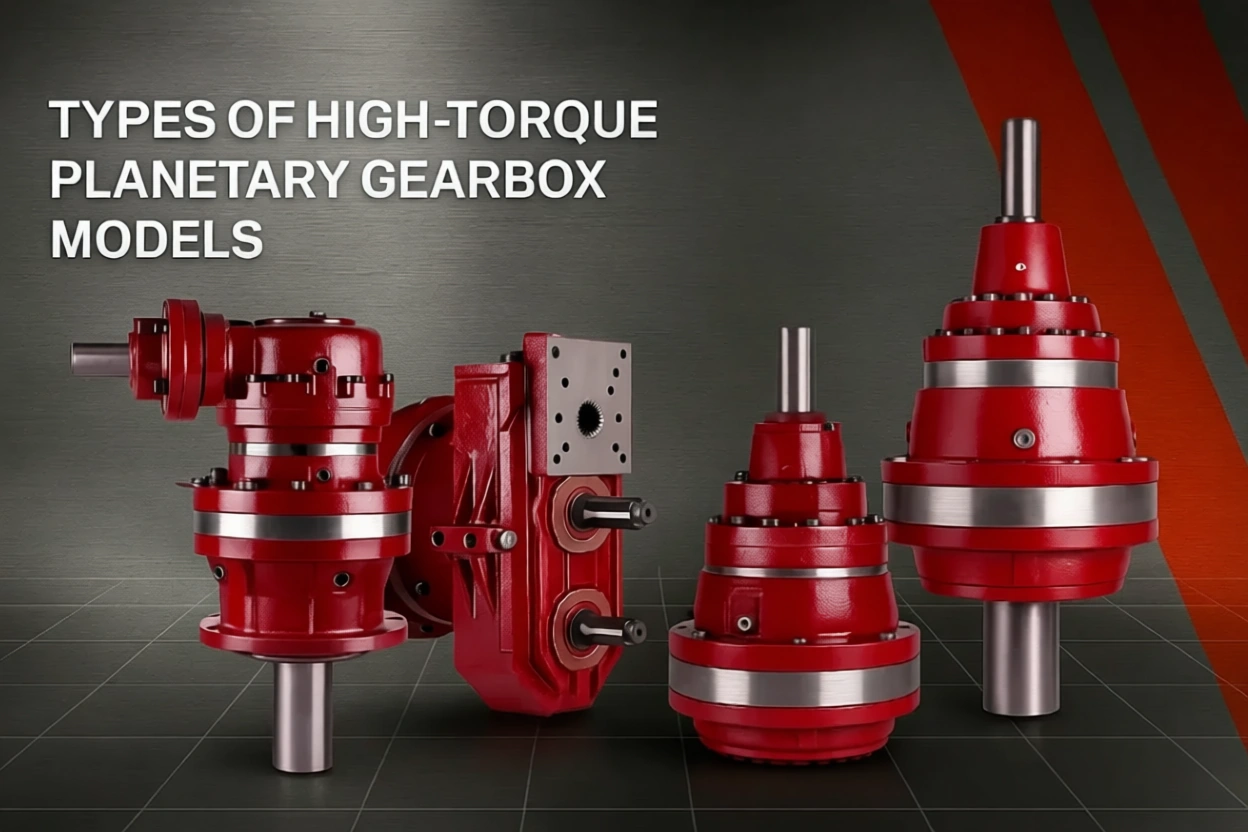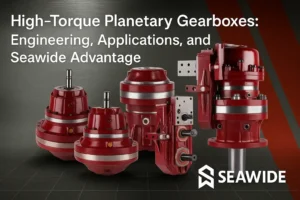High‑Torque Planetary Gearbox: Engineering, Applications, and Seawide Advantage

What Is a High‑Torque Planetary Gearbox?
A high‑torque planetary gearbox is a compact mechanical drive specifically engineered to deliver high power density and superior torque transmission within a small footprint. It operates based on the fundamental epicyclic gearing principle involving three main components: the central sun gear, multiple planet gears that revolve around the sun gear, and an outer ring gear (annulus) that meshes externally with the planet gears, often acting as the stationary housing element. This sophisticated configuration achieves remarkably uniform load distribution among the multiple planet gears, allowing the gearbox to transmit extremely high torque levels relative to its physical size and mass.
How It Works
Torque transmission initiates when the input shaft, typically connected to the sun gear, begins rotation. The planet gears, mounted on a structural element known as the planet carrier, engage with both the sun gear and the internal teeth of the ring gear. As the sun gear rotates, it forces the planet gears to revolve around their own axes while simultaneously orbiting the sun gear. The planet carrier is connected to the output shaft. By designing the gear ratios correctly (often by holding the ring gear stationary, creating a speed reducer), the output speed is reduced, and the output torque is magnified proportionally.
Because several planet gears share the load simultaneously, the gearbox can transmit significantly more torque and handle severe shock loads far better than conventional parallel-shaft gear trains of similar size. High‑torque designs optimize these kinematic interactions by employing multiple reduction stages arranged sequentially (cascading), utilizing case‑hardened and precision‑ground alloy steels for the gear teeth profiles, and incorporating superior bearing systems to manage the increased radial and thrust loads inherent in high power transmission.
Key Benefits of High-Torque Designs
The engineering focus on maximizing torque density yields several quantifiable advantages over other gearbox types:
- Torque Density: High‑torque planetary systems can achieve torque ratings up to 3× higher than conventional parallel-shaft helical gearboxes of an equivalent physical volume. This is mathematically represented by the increased load sharing capability:
[ T_{\text{Output}} = T_{\text{Input}} \times i \times \eta ] Where $i$ is the reduction ratio and $\eta$ is the efficiency, but the physical limit is dictated by the surface durability and bending strength of the interconnected teeth. - Compactness: The in‑line, concentric nature of the design minimizes installation length and width, leading to an exceptionally high output torque rating per unit mass ($\text{Nm/kg}$). This is crucial in applications like mobile machinery where space constraints are severe.
- Durability and Reliability: Durability is significantly enhanced through meticulous manufacturing processes. These include deep case‑hardening via carburization (achieving a case depth often exceeding 1.5 mm), precision grinding of the gear profiles to achieve extremely tight tolerances (e.g., AGMA Quality 12 or ISO Class 5), and specialized surface finishing techniques (e.g., shot peening) to enhance fatigue resistance.
High‑Torque Planetary Gearboxes
While both gearbox types fundamentally rely on the epicyclic gearing principle, their design philosophies and material specifications diverge significantly when catering to different operational demands. Standard planetary gearboxes are often optimized for lower loads, higher precision (low backlash), and lower cost, whereas high‑torque variants prioritize robustness and longevity under extreme cyclic loading.
The differences are summarized in the table below, highlighting critical engineering decisions:
FeatureStandard Planetary GearboxHigh‑Torque Planetary GearboxRationale for High‑Torque DesignTorque RangeModerate (Typically $\leq 2000 \text{ Nm}$)High ($> 5000 \text{ Nm}$ up to $2 \text{ million Nm}$)Requires increased cross‑sectional area and optimized contact ratios.MaterialStandard high‑strength alloy steel (e.g., 20MnCr5)Carburized & ground Cr‑Mo steel (e.g., 18CrNiMo7‑6)Superior core strength and case hardness for wear and pitting resistance.BearingsCompact deep groove ball bearingsSignificantly oversized tapered or heavy-duty cylindrical roller bearingsMust manage substantial radial forces and axial thrust loads from multi-stage reduction.Gear Surface FinishMachined or precision hobbed (e.g., ISO 1328 Class 7-9)Super‑finished, precision ground (e.g., ISO 1328 Class 5–6)Minimizes friction losses and surface stress concentrations.Stage StructureSingle or Dual stage sufficientHeavy multi‑stage cascade (3 to 5 stages common)Required to achieve very high ratios while keeping component size manageable.Thermal ManagementPassive heat dissipation through housingActive lubrication cooling circuits and enhanced finned housingsEssential to manage heat generated by high friction coefficients under sustained maximum torque.
High‑torque models integrate further reinforcement, including optimized bearing spacing to reduce shaft deflection, substantially thicker and more rigid planet carriers manufactured via casting or heavy machining, and finite‑element validated shafts designed to withstand peak momentary overloads (e.g., $2.5\times$ rated torque). These characteristics ensure the gearbox maintains its target ratio and performance metrics even under harsh, sustained duty cycles typical of heavy industry.
Click here to view our planetary gearbox products and their technical information.
Applications of High‑Torque Planetary Gearbox
High‑Torque Planetary Gearbox are indispensable in sectors where massive mechanical power must be precisely controlled and transmitted reliably under severe operational stress, high temperatures, and abrasive environments.
Industrial Sectors Requiring High Torque Density
- Mining & Quarry Machines:
- Conveyor Drives: Handling long, steep belts requires continuous high torque, often exceeding $500 \text{ kNm}$ for mainline drives.
- Crushers and Grinding Mills: Ball mills and SAG mills require massive breakaway torque to initiate movement, often using specialized right-angle planetary drives coupled directly to the mill shell.
- Stacker‑Reclaimers: Precise slow positioning combined with high load handling for stockpiling operations.
- Steel and Rolling Mills:
- Continuous Casting Machines (CCMs): Precise control over strand withdrawal speed, demanding gearboxes capable of handling high starting torques and managing thermal expansion.
- Ladle Turrets and Tilters: Extremely high static holding torque requirements coupled with slow, controlled movement.
- Billet Manipulators and Transfer Cars: High shock load resistance during material handling.
- Cement Industry:
- Rotary Kilns: The main drive system for large kilns requires robustness to overcome friction from refractory wear and material buildup, often demanding inputs over $1000 \text{ kNm}$ at the output flange.
- Vertical Mills (VRMs): Input drives for the grinding table rotation.
- Renewable Energy (Wind Turbines):
- Yaw and Pitch Control Systems: While lower torque than the main drivetrain, these systems demand high reliability and precision reduction ratios to manage nacelle orientation against high wind loads.
- Petrochemical Equipment:
- Large Pump Drives and Agitators: Essential for processes requiring slow, continuous high torque in potentially hazardous (explosive) environments, often necessitating ATEX compliance.
- Marine & Offshore Applications:
- Towing & Anchor Handling Winches: Require immense, consistent pulling power.
- Cranes (Pedestal, Knuckle Boom): High cyclical loading and environmental resistance.
- Azimuth Thrusters and Propulsion Systems: Planetary gearboxes offer a compact way to couple high‑speed electric motors to slow propeller shafts.
- Heavy Construction Equipment:
- Excavator Swing Drives and Track Drives: Must withstand extreme shock loads and abrasive dust ingress.
- Drilling Rigs (Top Drives and Drawworks): Handling immense static and dynamic loads during drilling operations.
Integration Capabilities
Modern High‑Torque Planetary Gearbox are designed for seamless integration with various input sources. They connect efficiently with standard industrial electric motors (AC/DC), high‑performance servo motors (for servo-controlled systems), or hydraulic motors (especially in older or specialized off-road machinery). They are capable of supporting massive torque ratings, often specified in engineering units as $\text{MNm}$ (Meganewton meters) for the largest mining applications, while consistently maintaining high mechanical efficiencies typically ranging from 95 % to 97 % under full rated load.
Click here to view our planetary gearbox products and their technical information.
High‑Torque vs Low‑Torque Planetary Gearboxes
The choice between a high‑torque, heavy‑duty planetary reducer and a low‑torque, precision model hinges entirely on the primary application requirements: maximizing endurance versus maximizing positional accuracy.
ParameterHigh‑Torque (Heavy-Duty Series)Low‑Torque (Precision Series)Design PriorityTypical ApplicationsLarge cranes, steel mills, cement kilns, marine winchesHigh‑speed robotics, medical machinery, precision positioning systems, small automationEndurance vs. AccuracyOutput TorqueGenerally $> 5000 \text{ Nm}$ up to $2 \text{ million Nm}$Typically $< 1000 \text{ Nm}$Load capacityEfficiency$94 % – 97 \text{ %}$ (Slight loss due to larger bearings/seals)$96 % – 98 \text{ %}$ (Optimized for minimal internal friction)Energy useBacklash$3 – 10 \text{ arc‑minutes}$ (Acceptable for bulk movement)$\leq 3 \text{ arc‑minutes}$ (Critical for smooth control)Positional accuracyWeightHeavier per unit of output speed reductionLightweight, utilizing aluminum or magnesium housings where possiblePower density vs. Inertia
For high‑load environments, the primary focus shifts entirely to torque capacity and thermal stability. A high‑torque unit is engineered with thicker housing walls, robust internal gearing designed for bending strength (not just surface durability), and substantial thermal management capacity. Hence, Seawide’s heavy‑duty planetary series specifically incorporate features like reinforced carrier flanges, advanced anti‑friction coatings on sliding surfaces, and utilize service factors ($\text{SF}$) often rated $\geq 2.0$ to account for extreme or poorly defined load inputs common in mining environments.

Other Key Features of Planetary Gearboxes
The inherent architecture of the planetary system provides several universal advantages leveraged in high‑torque designs.
Compact Power Transmission
The unique stacking of the gearing components in a coaxial configuration means that the output shaft sits concentric with the input shaft. Because torque is shared across multiple planet gears (e.g., three or four planets), the individual tooth loads are reduced. This crucial load-sharing mechanism allows the entire assembly to remain significantly smaller than a comparable parallel-shaft gearbox required to transmit the same torque. This results in superior power per unit volume.
Load Equalization and Durability
In a perfectly manufactured planetary set, the load is theoretically distributed equally among all planet gears. This uniformity in stress distribution dramatically reduces localized wear patterns, leading to smoother, quieter operation and significantly extended service life compared to single-mesh gear systems where one set of teeth might bear a disproportionate load.
High Efficiency
Planetary systems exhibit excellent mechanical efficiency. When manufactured to precision standards (as is essential for high‑torque duty), where tooth contact ratios are optimized and profiles are accurately ground, the resulting friction loss is minimized. Efficiencies commonly settle in the 95 % to 97 % range even when operating close to the thermal limit under full rated load.
Thermal Control Strategies
Sustained high torque inevitably generates substantial heat through friction, particularly at the input stage and within the churning of the lubricant. To maintain stable lubricant viscosity and prevent thermal degradation or micro‑pitting on the gear teeth surfaces,High‑Torque Planetary Gearbox employ sophisticated thermal control:
- Finned Housings: Maximizing the surface area exposed to ambient air.
- Forced Lubrication: Integrating oil pumps to circulate lubricant through external heat exchangers or cooling jackets surrounding the gearbox housing.
Low Noise and Vibration
While heavy machinery often tolerates higher noise levels, precision manufacturing pays dividends in reduced vibration, which lessens wear on adjacent components (bearings, couplings). Manufacturing planetary gears to high tolerance classes, such as AGMA class 12 or better, can result in measured vibration levels being up to 30 % lower than those found in standard, lower‑tolerance reducers operating under similar conditions.
Click here to view our planetary gearbox products and their technical information.
Types of High‑Torque Planetary Gearbox Models
High‑Torque Planetary Gearbox are often specialized based on the required input/output orientation and the necessary reduction ratio complexity.
Model TypeConfigurationTypical Reduction Ratio Range ($i$)Primary Usage ExamplesInline (Co‑axial)Input and output shafts are concentric (on the same line). Simplest configuration.$3:1$ to $1000:1$ (via multi-staging)Wind turbine generator outputs, long conveyor belt drives, pump drives.Right‑AngleAchieved by integrating a bevel gear stage or a specialized right-angle planet assembly.$5:1$ to $500:1$Compact installation requirements, stern tube drives, marine cranes where shaft orientation is fixed.Multi‑Stage ModularTwo, three, or four individual planetary stages cascaded together sequentially.Ratios up to $4000:1$ or higherExtremely slow speed applications like large cement kiln drives or specialized mill drives.Custom HybridIncorporates planetary stages followed by or preceded by other gear types (e.g., helical or bevel).Dependent on specific OEM requirementCustom machinery, large machine tool drives, or integrating with existing drive trains.
Each model type supports modular torque scaling. For instance, Seawide’s U‑Series heavy-duty planetary reducers are designed with a parallel shaft modular concept, allowing the internal component stages to be swapped or duplicated to accommodate a massive torque range, from approximately $15 \text{ kNm}$ up to $1800 \text{ kNm}$ per single drive unit, depending on the final configuration size (e.g., Frame size P400 to P900).
Maintenance of High‑Torque Planetary Gearbox
The investment in a high‑torque planetary gearbox demands a rigorous, preventative maintenance schedule. Due to the high energy density stored within the system, failures can be catastrophic, leading to lengthy and costly operational downtime.
Standard Maintenance Practices for Extended Life
- Lubrication Management: High‑torque units almost universally require high‑quality, synthetic, Extreme Pressure ($\text{EP}$) gear oil. Viscosity grades (e.g., $\text{ISO VG 220}$ for moderate loads, $\text{ISO VG 460}$ for extreme shock/heat) must strictly adhere to the manufacturer’s specifications. Oil levels and contamination checks should be performed routinely, typically every 500 to 1000 operating hours.
- Temperature Monitoring: Oil sump temperature is the most immediate indicator of excessive internal friction or overload. Continuous monitoring is essential, and the gearbox should be immediately checked if the oil temperature consistently exceeds $90 \text{ °C}$ under continuous duty cycles.
- Vibration Analysis: Regular (e.g., quarterly) monitoring of bearing housings and carrier mounts using accelerometers helps detect early signs of internal component wear, gear eccentricity, or subtle shaft misalignment before catastrophic failure occurs.
- Seal Integrity: Seals are the first line of defense against water and abrasive ingress. Due to the high operating pressures and temperatures in heavy-duty gearboxes, seals typically require proactive replacement schedules, often every $10,000$ to $15,000$ operating hours, or immediately upon detection of any external leakage.
Predictive Maintenance Integration
Modern heavy industry increasingly relies on Predictive Maintenance ($\text{PdM}$). For high‑torque units, this involves deploying in‑line sensors:
- Oil-Condition Sensors: Monitoring particle count, water content, and oxidation levels in real time.
- Acoustic/Ultrasound Diagnostics: Detecting the specific high‑frequency signatures associated with gear micro‑pitting, spalling, or developing bearing faults long before they register on standard vibration analysis equipment.
Seawide Support Commitment
Seawide emphasizes minimizing downtime. This commitment is supported through offering specialized maintenance training programs for client technical staff, maintaining strategic global inventories of critical spare parts (carriers, shaft assemblies), and offering comprehensive service contracts that incorporate periodic on‑site inspection and oil sampling by certified Seawide technicians.
Leading Manufacturers of High‑Torque Planetary Gearbox (featuring Seawide)
The global market for industrial planetary drives is highly competitive, featuring established leaders known for modularity and specialized expertise. Prominent global players include Bonfiglioli, Rossi, Reggiana Riduttori, and Brevini, who supply robust modular drive solutions for cranes, marine applications, and wind energy across the world.
However, Seawide carves out a distinct competitive niche by successfully merging the high standards of European engineering precision in design and metallurgy with a highly efficient, vertically integrated manufacturing approach, often resulting in a 30 % to 40 % cost advantage over comparable competitors for equivalent load ratings.
Seawide’s Engineering Edge and Certifications
Seawide’s competitive differentiation is built on tangible engineering superiority and strict adherence to international quality standards:
- Quality Assurance: Production facilities are certified compliant with ISO 9001 for quality management, and designs are rigorously checked against AGMA standards (specifically $\text{AGMA 6113}$ for gear quality and sizing) and relevant $\text{ISO}$ norms.
- Customization: A core strength lies in providing torque stages that are precisely engineered to the client’s peak load requirements ($\text{Duty Cycle Load Spectrum}$), avoiding unnecessary oversizing or dangerous under-specification.
- Structural Integrity: All critical load-bearing components (housings, carriers) undergo extensive Finite Element Analysis ($\text{FEA}$) to validate mechanical stress distribution under transient and sustained peak loads.
- Material Traceability: Complete material traceability protocols ensure that every component, from raw ingot to finished ground gear, is documented and verified against specified alloy composition.
- Agile Manufacturing: Utilizing modular in‑house production capabilities allows Seawide to maintain one of the shortest delivery cycles in the heavy-duty market segment for custom configurations.
Comparative Product Advantage (Seawide U-Series)
Seawide’s premier heavy-duty product lines, such as the U‑Series and H‑Series reducers, consistently demonstrate superior performance metrics in the field:
- Overload Capability: These units are typically designed to withstand up to 2× the continuous rated torque for short periods (e.g., $5$ seconds) compared to standard modular types, crucial for emergency stop or shock startup sequences.
- Bearing System: Seawide utilizes heavy, high‑capacity tapered roller bearings exclusively, specifically selected to manage the high thrust loads imposed by the stacked planetary reduction stages.
- Environmental Sealing: The design incorporates advanced sealing systems achieving an ingress protection rating of IP67 as standard, necessary for reliable operation in the submerged (marine) or extremely dusty (cement, mining) environments where these gearboxes are deployed.

About Seawide – Precision Engineering for Planetary Gear Systems
Seawide is recognized globally as a specialized manufacturer dedicated exclusively to high‑performance industrial drive solutions, with a core expertise rooted deeply in the design, analysis, and production of planetary gear reducers tailored specifically for heavy‑duty and high‑torque applications. Established over two decades ago, the company has built its reputation on delivering robust mechanical systems where reliability is non‑negotiable.
Company Expertise and Compliance
Seawide’s engineering foundation is built upon strict adherence to global manufacturing and design benchmarks:
- Design Experience: Over $20$ years focused exclusively on the challenges of high‑torque density transmission.
- Manufacturing Technology: Integration of cutting‑edge $3\text{D}$ Simulation tools, advanced $\text{CAD/CAM}$ programming for complex gear cutting, and highly automated, closed-loop heat‑treatment lines guarantee metallurgical consistency.
- Standardization: Full compliance and design validation against critical industry standards including AGMA 6113 (Gear Design), ISO 1328 (Gear Accuracy), and DIN 3990 (Gear Rating), ensuring international interchangeability and predictable performance.
Core Product Portfolio Highlights
Seawide organizes its high‑torque offerings into specialized series to meet distinct industrial demands:
- U‑Series (Ultra‑High‑Torque): The flagship line featuring modular sizing capable of handling the absolute highest torque densities across parallel shaft configurations, ideal for the most demanding mill and winch applications.
- H‑Series (Heavy‑Duty Inline): A robust family of inline reducers optimized for standard industrial conveyor and mixer drives, balancing high torque with cost‑effectiveness.
- M‑Series (Marine Certified): Gearboxes specifically engineered and certified by maritime classification societies (e.g., $\text{DNV}\text{–}\text{GL}$ approved) for use in propulsion, dredging, and offshore lifting, meeting stringent vibration, corrosion, and reliability standards.
Comprehensive Services & After‑Sales Support
A reliable gearbox requires reliable support. Seawide extends its partnership beyond the factory gate by offering:
- Engineering Consultation: Dedicated teams provide detailed analysis for drive sizing, failure mode and effects analysis ($\text{FMEA}$), and application support.
- Custom Gearbox Design: Rapid iteration design capabilities for specific $\text{OEM}$ integration challenges.
- Field Service: Availability of factory‑trained technicians for on‑site commissioning support, detailed failure inspection, and critical repair services.
- Logistics: Maintaining substantial global inventory of standardized components ensures rapid dispatch of essential spare part kits and replacement gear elements, minimizing customer inventory requirements.
Global Footprint and Quality Control
With an established distribution and service network spanning Asia, Europe, and the Middle East, Seawide ensures both rapid delivery logistics and prompt local service response. Crucially, every single high‑torque planetary gearbox manufactured by Seawide undergoes a comprehensive, documented full-load endurance testing sequence on a dynamometer rig equivalent to $120 \text{ %}$ of its rated torque before final shipment approval.
Click here to view our planetary gearbox products and their technical information.
Conclusion – Power, Precision, and Seawide Reliability
High‑Torque Planetary Gearbox represent the pinnacle of modern mechanical transmission technology. They successfully merge the demand for immense mechanical leverage with the requirement for compact integration, efficiency, and operational endurance needed to survive the world’s toughest industrial operations—from the crushing forces in deep mines to the continuous pull of marine winches and the demanding cycles of rolling mills.
In this critical sector, Seawide’s dedication to engineering excellence is clearly demonstrated through product designs that guarantee unwavering torque delivery, industry‑leading energy efficiency, and operational safety margins that exceed standard expectations. By focusing on material science and precision manufacturing, Seawide offers a reliable, long‑life alternative in the global heavy-duty drive market.
For in‑depth engineering consultation, detailed technical specifications, or to initiate a quotation process for a high‑torque solution tailored to your specific operational parameters, please visit the official Seawide resource portal at https://seawide-gear.com or engage directly with the Seawide global engineering support team.


